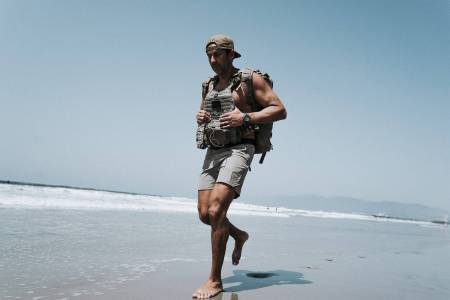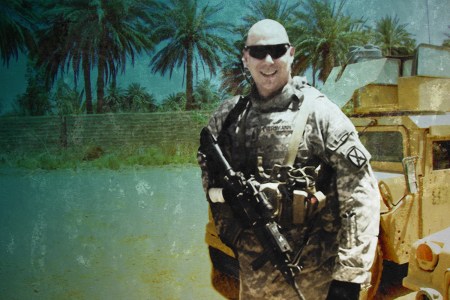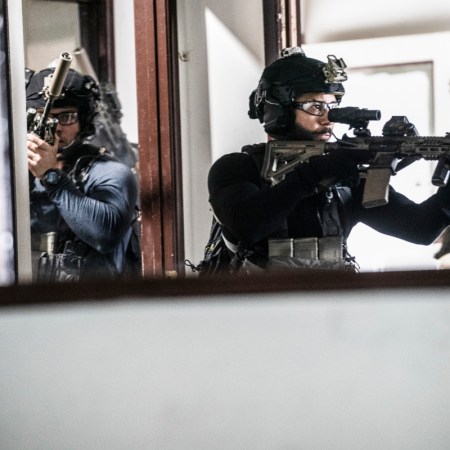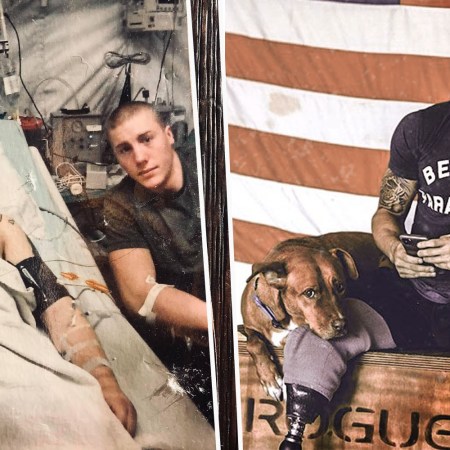Green Beret Lieutenant Colonel Matthew A. Chaney had no idea when he took over the 3rd Battalion, 10 Special Forces Group, that he’d command the last special forces unit of the War in Afghanistan.
Despite an an active career with the Green Berets, and a military service that began before the attacks on 9/11, this was Chaney’s first deployment to the country. Roughly four months into operations, while coordinating special forces teams in the region and running a school house program to train the embattled Afghan National Army, word came down from command in April that U.S. forces would leave Afghanistan before September.
The months that followed were extremely challenging, with Chaney having to close eight military bases (most of which had been the size of small cities at one point or another) while trying to run missions against the unyielding Taliban. Filmmaker Matthew Heineman was there on the ground to experience this time through the eyes of Chaney’s Green Berets, who feature prominently in his National Geographic documentary Retrograde. It’s named after the military term for the removal of tactical equipment from a forward operating location.
We spoke with Chaney about his experience in Afghanstan, reliving those months through Heineman’s doc and his continuing efforts to help the Afghan allies we left behind.

How did your military career begin and what drew you to become a Green Beret?
I was commissioned into the Army two months before 9/11, so my whole career has been in a post-9/11 environment. I started off as a deep-sea dive officer, which led to operations underwater all over the Pacific. I enjoyed that work. I started to get a lot of recommendations from colleagues to join the special forces around 2005. I went through selection and passed my special forces training, arriving in my unit around 2007. I was deployed immediately to Iraq, where I ended up going a couple of times. In my younger years I was shot at, shot up, blown up, wounded. Following those tours I was shipped out to Africa, Eastern Europe, and Syria for counter-ISIS missions. I found power in the unique way that the Green Berets operate, partnering closely with regional forces and focusing more on those relationships than other special forces.
When did you first hear that you would be deploying to Afghanistan?
I was never sent to Afghanistan during my earlier years in the special forces. I was sent just about everywhere else. That changed when I took over the 3rd Battalion, 10th Special Forces Group, which became the core of the task force in the area. By the time I headed out to Afghanistan, it was the very beginning of January 2021. The was a change in presidential administrations in the United States at that time, as you may remember, and there was already an agreement in place with the Taliban that we were going to withdraw our forces. This was looming on the horizon, but the exact timeline was still very unclear. The Department of Defense was raising different opinions on whether or not we should keep some presence there. So we were still running combat missions, even if it was to a reduced degree. Our school house program was a large focus, which we were running in order to train up the Afghan forces.
Navy SEAL Kaj Larsen’s Guide to Becoming a Better Swimmer
The best waterman in his class talks dolphins, breath exercises and something called “surf torture”Can you explain what your force was comprised of, and the goals of the school house program you mentioned?
The Special Operations Task Force Afghanistan, or SOTF-A, was comprised of 16 different countries and roughly 1,400 people. Despite the consolidation of some of the forces, I was still running eight bases with special forces teams that touched all four corners of the country. Our forces were aligned with our NATO partners and others to run the school house program to train the Afghan forces for combat. The training was based off of our own special forces training, but by the end it had been edited down quite a bit based on the need. The Afghan special operations were losing roughly 1,200 people a month. We were doing our best to help get their forces as ready as possible before they showed up on the front lines.
What was it like first meeting with the Afghan forces that you would be working with and training?
I was new to Afghanistan, but I had all of the credibility and relations that had been built by the task forces before us. Being a Green Beret meant a lot to many people who lived in the area and worked with the United States. The Afghan special forces soldiers had gone through our own training and a lot of them had adopted our DNA, to a degree, on the military side. These guys walked and talked like us. I was invited to many a wedding in Kabul, even if I wasn’t always able to make it, and the respect was mutual. My primary partner was the young Afghani general Haibatullah Alizai, part of this next generation of Afghan leaders being put in place who had come up with U.S. Military. I may not have had as much history as others in the country, but as a commander I saw the losses they were suffering and how it affected him. That bonded us very quickly.
How the Army Ranger From “Black Hawk Down” Is Helping Other Veterans Tell Their War Stories
He may be retired, but Matt Eversmann’s commitment to the troops lives on in his writingWhat were the challenges you were dealing with as a commander in that situation?
There was definitely challenges that came with the fact we could be leaving at any point. Local relations had already been difficult to maintain during the pandemic. We hadn’t been able to spend as much time in the room with our allies and locals as we had previously. So every room that I was going in for the first time, there was always this lingering threat that one of the locals had been turned by the Taliban. There had been cases of the Taliban threatening locals, or pushing them to kill Americans under the threat of mortal danger to their families. These situations were amplified by the looming eventuality that we would be leaving the country, and taking all the support that we provided with us.
What was it like when you and your team first heard that the president would move forward with pulling US forces out of Afghanistan?
There were operators on my team who had spent their entire military careers in Afghanistan and with the Afghan people. They had made friends in the country, they had lost friends in the country. As you can imagine, the news about the retrograde hit them harder than it hit me. Perhaps that helped me focus a bit more on our country’s priorities when it came to the withdrawal, as I had less history with that soil. Despite the fact I had less history with Afghanistan, it didn’t block me from being affected by the reality as a human being. I think we all realized that our partner forces were going into a very difficult situation without us there, no matter how well we had prepared them.
I had a strong relationship with my primary partner, the general, and I saw the hurt he experienced when his force suffered casualties. We knew that more of that was coming. There were nights when we were able to provide medivacs for men of his that were injured, and that wasn’t going to a possibility anymore. The other fact you have to realize is it wasn’t just one definitive announcement made, which everyone in Afghanistan instantly accepted. Our partner forces were hearing different things from different channels, and some were still hearing that we were going to be staying behind in some capacity. From social media to news outlets, there were so many sources that they were looking at and hoping to believe in some capacity.
Once the retrograde was officially ordered, how did you start the process of shutting down operations?
There were eight bases that we needed to close down, and at various points in time these bases had been as big as small cities. Our forces were being reduced throughout the process, and I also had the charge of maintaining security through this process, which was a huge responsibility. There were a lot of resources on the ground, and there were very clear protocols for what we were to do with each piece of gear. Some equipment needed to come back home, some needed to be destroyed, the rest we were able to hand over to the Afghan forces. There were hundreds of tons of ammunition, televisions, computers, and water. There were some wild claims about how much we left behind, but there was a lot that we took home with us. We carried our own weapons out, as much as I am sure they would have liked to have them. For the vehicles that we could leave, there was official paperwork to sign them over.
The majority of the bases were named after fellow soldiers who had died in the line of duty, which added an element of emotion to closing each one. We had a little ceremony for the fallen when we lowered the flag down the pole. I’ve since delivered those flags to the families of those fallen soldiers, the last one being dropped off just a few months ago. The last base we closed was the one I had spent the most time on, and it was the toughest. I was still running operations to the very last minute. In the haste of everything we had almost forgotten a plaque that was drilled into a rock there on the base, and I had to hold the helicopters while we chiseled the plaque from that rock, so we could get it to his family.
Do you remember your last night in Afghanistan?
I had dinner with the Afghan general the night before we left, at his place in Kabul. There was about a dozen of us reflecting over grilled lamb. Everyone was on the verge of tears. There was a lot of respect in that room. The general said he looked forward to welcoming me back into the country as a contractor. He would hire me to keep our mission going. He pointed out the apartment that he would put me up in and the office that I would have. That was how we had to think about it, because it was too difficult to talk about any other option. We were all hopeful that the Afghan forces would be able to take over effectively, even if that didn’t match the intel we had. We gave our hugs goodbye.
My team’s actual departure from the airport was anticlimactic. It was two o’clock in the morning, there was about 35 of us there to lower the last flag at Kabul International Airport where we had a small compound. That was the last special forces flag to leave that operation. It was very somber. There was no band. There was no fanfare. There was no crowd. Just a lot of people exhausted from doing the best we could for the country and its people.
Everyone has seen those saddening images from the airport in Kabul of people trying to get on those last planes that were leaving. Being someone who had worked with Afghans, and had entire bases full of people who probably wanted to fly out with you, how difficult was it to experience?
In a perfect world, we would have a lot longer to prepare for the retrograde, but we still felt like we did as well as possible. There was very little sleep during those weeks. That’s what made the chaos what happened at the airport so heart wrenching, because of all of the effort that we’d made to prevent anything like that happening. But it was hard not to sense the desperation in the people when we were closing our bases. During those final days, every person working on the base was asking to be taken with us. No bureaucracy was going to be able to figure out how to get them out of there in seven days. Once the people on the base began to realize that we couldn’t bring everyone, no matter what we wanted, things started to feel a little desperate. The next step was them asking us for recommendation letters for their access to the airport.
They all thought that if they had a personal note from Lieutenant Colonel Matt Chaney it could be a golden ticket onto a transport plane. They wanted something that they could hold up to the military personal at the entrance to help get through the crowds. But that’s not how it worked. I didn’t even have the ability to bring anyone I wanted through the gate in person. I had a female interpreter who had worked with the special forces for years, whose family I tried to walk through the gate. I was speaking with the Marine on the other side, explaining who I was, and there was still nothing he could do. It was a tough position for him, and it broke my heart. I was eventually able to get her out five months later.

Once you had left, what was it like hearing how quickly things started to fall apart in the Afghanistan government and after that, the military?
Nobody predicted how rapidly things would decline from the inside out on the political side. The Afghans were still fighting when their president left the country, and that news made its way to all of the fighters on the front lines. They started to ask what they were even fighting for, if there wasn’t a government anymore. It wasn’t that they didn’t want to fight for their country, but their government wasn’t providing any kind of security for what they were fighting for. I think a lot of people missed that fact.
There were also challenges that the Afghan National Army were facing, which we would help them handle when we were around. The country of Afghanistan is huge, and even though they had the gear that they needed to fight the war, they couldn’t get everything where it needed to be. There were reports that they were running out of ammo, but the real issue was they couldn’t get the ammo where it needed to go. They had limited aircraft and the Taliban were cutting off all of the major highways. I don’t want to be just another senior leader in the military saying that we just needed another year to get them ready, but it’s hard not to wonder what we might have done for them with more time.
Given how profoundly complicated your mission was in Afghanistan, how was it having an award-winning filmmaker like Matthew Heineman following your unit?
I had my concerns about having cameras around, so I’ll start by saying I am grateful that Matt was able to make the documentary that he did. When I first heard rumors of a film team wanting to work with 10th Group, I made an argument against it. There was a lot of reasons I didn’t want that kind of distraction around my men as we prepared to go into the country, and especially while we were in the country. I was told that command wanted to do it regardless, so like any order I embraced it and went about trying to make it work. As you can imagine, there was a lot of initial resistance from my special forces operators. Most of them don’t even have social media and we were asking them to take part in a film project. I held quite a few town halls with my team, fielding questions from the soldiers and their families, where I had to answer a lot of tough questions. They were really difficult conversations, but I can say now I am truly glad that Matt was there and captured what he did. There are moments in the footage that even I hadn’t been able to see personally, and I think it serves as an important document to the relationships we made with the people of Afghanistan. I am glad that I have Matt’s movie to show to my kids at some point, so they can understand what I do.
What were the discussions around having cameras in the room when you were discussing operations and sensitive material?
Matt, his producer Cailin [McNally], and the rest of the team were very good about working with us, given the situation. They understood that even though they had a lot of access, we had to be able to tell them to shut off the cameras and audio at any time. That being said, they were in the room a lot and had a lot of insight into procedures that had never been seen before. Heineman’s style is about being there as much and often as possible. In certain circumstances we also had to deal with the security protocols for our partner countries if they were involved, so those were more difficult to negotiate. On occasion there was a lot of tension, and perhaps other film crews might have quit dealing with what they had to. There were constant security threats that we were dealing with, and they had to consider those as well.
What did you think of the footage that Heineman captured of the Afghan Army and one of their generals Sami Sadat?
I am very glad they got that footage. The Green Berets are unique in the way that we work with the regional forces, and the film shows that. We live, eat, and train with our partner forces. I had trepidation at the fact that once we were leaving Matt and his cameramen were going to try to stay in Afghanistan to continue filming with the Afghan Army. I couldn’t personally let them stay, because I was afraid that they could end up dead, so I made them fly out with me. They were able to get back into the country after we left and I’m glad they did, because they were able to capture scenes of the Afghan forces fighting as best they could against the Taliban. People will see the blood that was spilled and the sacrifices made in defense of their country.
Have you stayed in contact with your partners in the Afghan Army since the retrograde?
Part of me feels like I haven’t really left Afghanistan. I have an Afghan phone with a local number and an Afghan alias so that I can communicate with my contacts over there safely. Every single day I am working with some nonprofit in some capacity, trying to help the people we haven’t been able to get out yet. I have about 35 Afghan families that I am working to keep safe and fed while we work on their individual visa cases alongside a number of charities. The primary organization I am working with is the NMRG Rescue Project. NMRG stands for National Mine Reduction Group. These guys were founded to clear bombs for special operators as we were going on missions. Many of them worked with us for over 10 years. They worked with every Green Beret who came through there. There are about 300 left in the country still. They have a legitimate visa pathway into the United States.
They didn’t work for Afghanistan, they worked for the U.S. forces. So the goal of the rescue project is to keep their immediate families safe until we can get them over here. We are asking for the US government to prioritize their paperwork. These guys saved our lives and in some cases were wounded while trying to protect our forces. All told, about 3,000 people are looking to support. I also work with Operation North Star, which is meant to help the people who supported our American forces. These are people who have been screened or we personally know. These aren’t random people that we are trying to bring into America. These are people who worked and sacrificed on behalf of our country and their own.
This article was featured in the InsideHook newsletter. Sign up now.






















